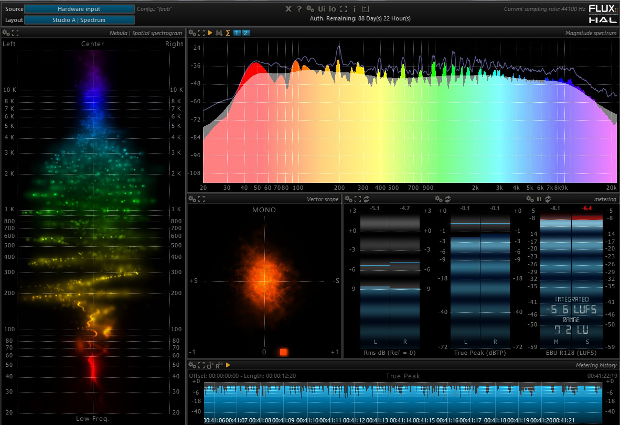FLUX is a wellknown plugin company from France that makes very good quality products. On todays testbench is the FLUX Pure Analyzer System.

Analyzing signals in the mix can be vital to todays clean and loud mixed recordings. Connection of the Pure Analyzer System is pretty easy, you can connect it directly to your soundcard or via using the Samplegrabber plugin. The Samplegrabber plugin can be put anywhere in the signal path and works also via network connections that can even be password protected. That way you can use it to view signals from different systems. A very clever option for big studios.
When first opening the plugin you immediately see a beautifully made GUI thats not only easy to look at but also very accurate to use. you can even invert the colors for use in dark environments. You can alter the setup of the GUI to your personal preferences, many options are available. The whole system consists of the Pure Analyzer Essential this is a standalone application that can be extended with Pure Analyzer Metering,Live and Multichannel options.
How the GUI works:
First you decide what layout you want via the options menu, you can choose from a plethora of options by selecting them in a dropdown menu, Next you can tweak all the metering and options to your liking. Every single element can be altered via the options menu thats reached through clicking on the little sprockets at the left top site of each element, or by right mouseclick and left to close it again.
There is a NEBULA (Spacial spectrogram) that accurately tells you what each frequency does in the spectrum and how wide it is. A very good way to check for instance your main lead synths for ultra wide frequency splitting above a certain frequency, a trick often used in todays dance music. Then there’s the Spectrum Analyzer the part that most people are familiar with that shows you the Magnitude Spectrum of the incoming signal. By using the middle mouse wheel you can zoom in on the wave form.
Next up there’s the Vector Scope to check for phase problems, signals between +1 to 0 are in phase, values towards -1 are going into out of phase territory. The metering consists of RMS (Root Mean Square) this is measuring the average power over the signal over a time period. Many presets are on board that conform to standards such as Bob Katz’s K-System, EBU and even broadcast standards such as the BBC. The weighting of the signal can be conform the itu 1770, Ansi A,B,C AND D standards. The manual goes into great detail of all the standards.
Also there’s the True Peak metering (dbTP) this measures overshoots above 0db peak also called overs that can wreak havoc on the eventual analog conversion. This is to prevent internal clipping of D/A converters. Then there’s the EBU Metering that can measure LU (Loudness Unit) & LUFS (Loudness Unit referenced to Full Scale). LU is used for relative metering and LUFS for absolute metering. This is relative new standard and it’s great to see that this is being implemented.
Lastly there’s the metering history field where you can see whats happening in your signal in real time. You can even pause the signal to watch very closely on certain parts. Many more options like Metering statics, Signal Generator, Impulse Response measurement etc are also available. This system is very deep and to get the full benefit of all the possibilities you definately have to have a look at the manual.
Final thoughts:
The FLUX Pure Analyzer System is a very well thought out concept, excellently suited for Mastering, Mixing and more while conforming to the best and wellknown standards of today. It’s a joy to work with and while you can very deep in the customizing it’s pretty easy to get to grips with. Very highly recommended if you want to know all the in and outs of whats going on inside your signal.
More info visit: www.fluxhome.com
Rob Fabrie
